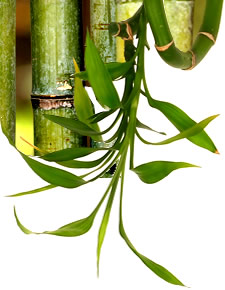

Building with bamboo |
This ancient, elegant material is more available than ever ASIANS HAVE KNOWN it for centuries: bamboo is one of the most useful materials for building garden structures. But structural bamboo hasn't been widely available in the United States until recently. Now, as trade around the Pacific Rim opens up, the supply is on the increase. You can buy imported bamboo from nurseries and mail-order sources in an array of forms--poles, fences, water pipes, and deer scares--as well as specialized tools for working with bamboo. If you haven't used bamboo, it has some characteristics you need to know about. One of the fastest-growing woody-stemmed plants (some kinds can grow a foot a day), bamboo is lightweight, beautiful, and surprisingly strong. The hollow shaft is strengthened every foot or so by solid nodes (growth points). One kind of bamboo is solid from end to end: it holds nails and screws securely, does not easily split, and is available as pressure-treated, rot-resistant wood. Bamboo has some weaknesses, too: most kinds tend to split, and rot easily when exposed to constant moisture. Because of bamboo's relative flammability, some communities in fire-prone areas have ordinances restricting its use. Check with your local fire marshal. If you build with these things in mind, you can make the most of bamboo's many strengths and minimize its weaknesses. POLES HAVE MANY USES Sturdy bamboo poles work well in fences, as bench seats when bound tightly together, and as supports for tall flowers and vegetables. They also make great trellises and arbors for climbing roses and vines. Bamboo poles come in roughly 1/2- to 4-inch diameters, and lengths from 4 to 12 feet. Costs run from less than 75 cents for a 6-foot length of 1/2-inch pole to $14 for a 12-foot length of 3-inch pole. You can buy bamboo in its natural brown color, or, for twice the price, buy wood that has been smoked, scorched, mottled, or dyed (green, red). Because a bamboo pole will rot when one end is buried in wet earth, it's best to set it in concrete that's just above soil level. Or you can slip the pole over a pipe or reinforcing-bar base; the bamboo's solid internodes will keep the pole from sliding down the pipe into the soil. FENCES AND SCREENS Split-bamboo fences that roll up have long been available, and cost about $7 per running foot for a 6-foot-tall fence. If you use these as covers for conventionally framed fences, they last longer if you keep the bottom slightly above the ground. Bamboo works well on cedar or redwood posts. You can make see-through fences from scratch or from kits. Bind poles where they cross using wire (precut pieces of galvanized wire cost 5 or 6 cents each), which you twist tight with a $6 tool. Cover the wire with traditional black hemp twine for an elegant finished look. Finally, ready-made sleeve fences, like the one pictured below left, start at about $300. In gardens with an Oriental flavor, sleeve fences serve well as screens to hide the likes of coiled hoses. WATER PIPES, DEER SCARES The sound of falling water in the garden does a great job of masking traffic noise and creating a restful ambience. Bamboo pipes raise the water just high enough to give it some splash when it streams into a pool, stone bowl, or on rocks below. Japanese gardeners often put a deer scare (one is shown below) under a falling stream of water; after the bamboo tube fills, it pivots, spills, and knocks against a rock, scaring any deer that have come to browse. If you're a patient woodworker who can contend with bamboo's tendency to split, you can make a deer scare like the one pictured for less than $20. Ready-made deer scares cost about $55. Getting water to flow through a bamboo pipe also requires some work, since you have to punch out with a length of rebar the solid internodes that block the otherwise-hollow bamboo shafts before you join the two pieces. Then you thread a plastic tube through the structure; the tube hooks up to a low-volume pump. A ready-made water pipe costs about $35. A submersible pump costs about $55 extra. GROW YOUR OWN BAMBOO If bamboo grows in your garden, you can use it for construction. Some varieties, such as giant or Japanese timber bamboo, grow to 50 feet or taller. Many kinds of bamboo are hardy down to 0 [degree]. For maximum strength, harvest bamboo stems when they're between 3 and 8 years old and cure them in a cool, dry place until stems turn dry and brown. |
© Copyright yayixm.com All rights reserved. Unauthorized duplication in part or whole strictly prohibited by international copyright law. |
|
|